Pocket Bees:Colony Simulator ist ein Spiel, in dem du, wie der Name schon sagt, eine Biene steuerst, deine anderen Bienen kommandierst und das Wachstum deines hübschen kleinen Bienenstocks verwaltest. Pocket Bees wird von Ariel Games, den Machern von Pocket Ants, entwickelt. Du sammelst Pollen, füllst Nektar auf, stellst Honig und Wachs her, bekämpfst Wespen von Blumen und machst andere ganz normale Bienensachen. Wie das Fangen von Vögeln, Spinnen und Mordhornissen und das Schicken in einer Arena als eine Art Blutsport!
Die meisten Versammlungen, die Sie durchführen, dienen dem PVP des Spiels. Sie sammeln Materialien, um Ihren Bienenstock zu verbessern, wodurch Sie noch mehr Materialien sammeln können, und verwenden Sie diese Materialien dann, um Bosse zu beschwören und die Bosse zu stärken, die Sie bereits erobert haben.
Dann gehst du ins PVP, um Propolis zu bekommen, ein Material, das du brauchst, um die mächtigsten Upgrades zu bekommen, damit deine Bienen besser sammeln oder deine Viecher besser kämpfen können. Bisher gibt es nur fünf Kreaturen, aber das macht es zu einem sehr taktischen Spiel, vorausgesetzt, Sie treffen auf jemanden mit der gleichen Kreaturenstufe wie Sie.
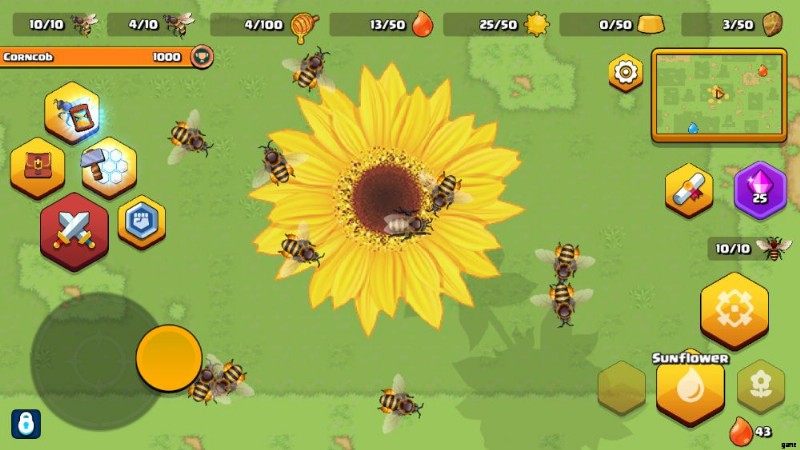
Unser Anfängerleitfaden für Pocket Bees konzentriert sich auf das frühe Spiel, da dies die größte Hürde ist, der Sie als Spieler begegnen werden. Dem PVP-Matchmaking ist es egal, dass du neu im Spiel bist, und sogar der Tutorial-NPC Noelle entscheidet sich gelegentlich dafür, dich mit einem Level-3-Team zu überraschen, wenn du dich entscheidest, stattdessen gegen sie zu kämpfen.
Es gibt nur wenige Bienen und das Sammeln von Ressourcen ist langsam, bis Sie Ihr erstes Foraging-Upgrade freischalten und anfangen, die Upgrades Ihres Bienenstocks zu erhalten. Wir hoffen, dass dieser Leitfaden Ihnen dabei hilft, das anfängliche Leiden im frühen Spiel zu überwinden und Sie auf den Weg zur Massenproduktion von Unmengen an Wachs für Ihre Kreaturen bringt.
1. GARTENLEBEN
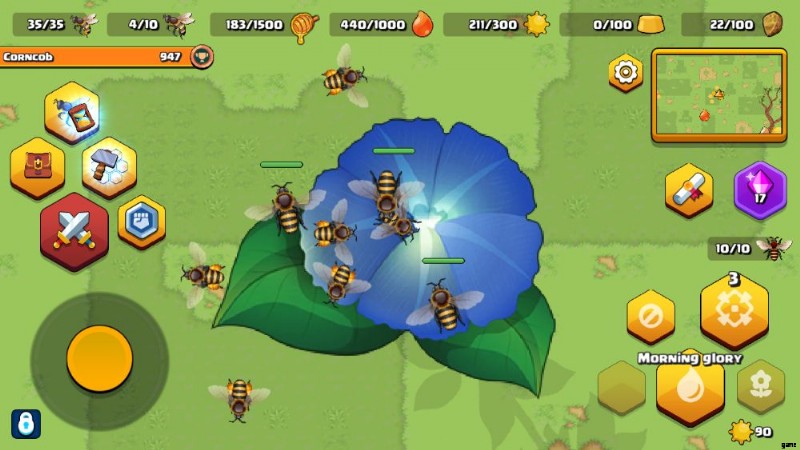
Die meiste Zeit werden Sie damit verbringen, Ihren Bienenstock zu verwalten, Ihren Bienen zu befehlen, Ressourcen zu sammeln, Kreaturen mit Ihren Wachbienen zu beschwören und zu bekämpfen und im Allgemeinen viel zu warten, normalerweise bis die Arbeiterbienen mit dem Sammeln fertig sind. Dieser Abschnitt ist spezifisch für diesen Teil des Spiels, vom Einfangen von Kreaturen in Vorbereitung auf das PvP bis hin zum einfachen Befehlen deiner Bienen.
Tag eins Top Gun
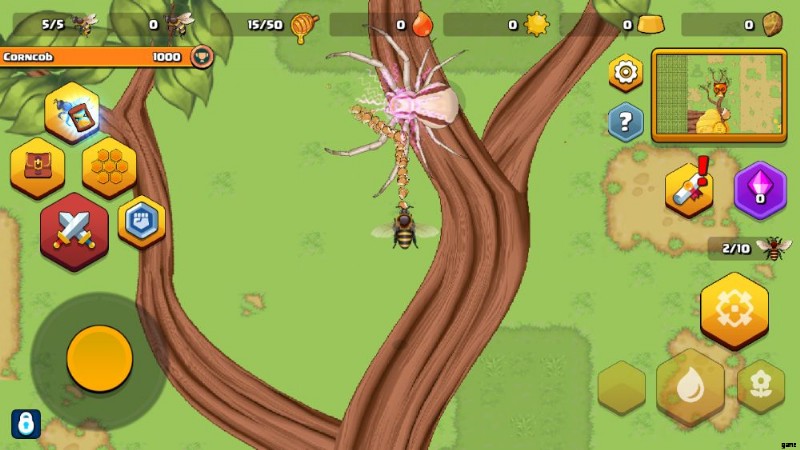
Ihr erster Tag in Pocket Bees ist der härteste von allen. Am Anfang gibt es viele Bedrohungen im Garten und keine Möglichkeit, echten Schaden zu verursachen. Deine einzige Waffe ist die Flüssigkeit, die du zufällig bei dir trägst.
Auf dem Baum, auf dem sich Ihr Bienenstock befindet, befindet sich ein Klecks Harz, und Sie sollten niemals das Haus verlassen, ohne einen Tropfen davon zu schnappen, zumindest bis Sie Ihren Garten von Bösewichten befreit haben. Sie können es auf ein feindliches Ziel spucken, um es lange genug zu betäuben, damit Sie sich sammeln und rennen können, was Sie tun müssen, da sich die ersten 3 Pollen, die Sie zum Freischalten von Guard Bees benötigen, auf einer Blume befinden, die von einer einzelnen Wespe bewacht wird. Betäube die Wespe, nimm den Pollen, bring ihn nach Hause, wiederhole es noch zwei Mal, hol dir dann eine Brutkammer und komm mit einem Geschwader von 5 Wachbienen zurück, um den Boden mit all den Wespen in deinem Garten zu wischen.
Wenn Sie Bienen finden, die nicht zu Ihrem Bienenstock gehören, können Sie sie direkt abschießen, um sofort einen Prozentsatz Ihrer maximalen Ressourcen zu erhalten, und 10 von ihnen erscheinen jeden Tag als eine Art kostenlose Beute. Note that you can do this with water too, though you need Resin to capture boss creatures for PVP.
You can also spray the liquid wider by moving your bee around, as the firing animation lingers a while. This allows you to stun multiple targets in one spit if done right. And don’t worry about shooting your buddies down, there is no friendly fire.
Squadron Flight
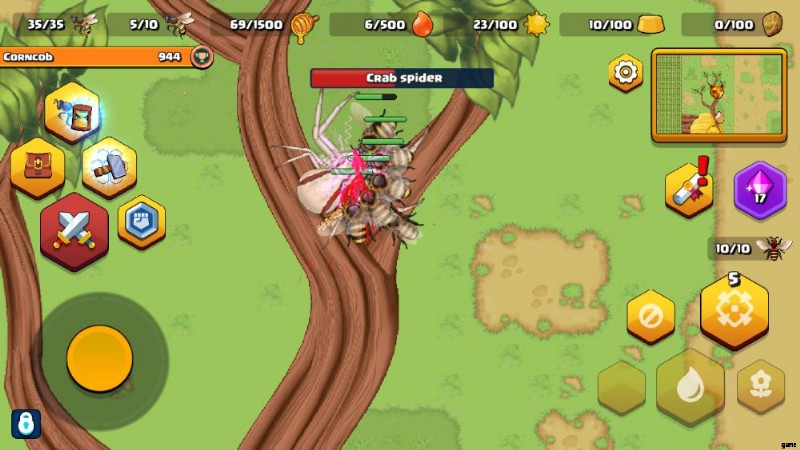
While you can stun enemies by spitting at them, you have no means of dealing damage at all. The only way you can hurt enemies is to upgrade your Brood Chamber to unlock Guard Bees. These guys can do damage to enemies and are each strong enough to take on two wasps before dying. Of course, if you lure away wasps then stun them, the Guard Bee can kill them without taking damage at all.
Always stun your target then move in for the kill to make the most of your Guard Bees. And if doing so, commit to the attack:Make sure all of your bee squadron is in combat before grabbing more water to stun, and remember to spray wide to hit as many wasps and bumblebees as possible in one spit attack.
Set Your Joystick
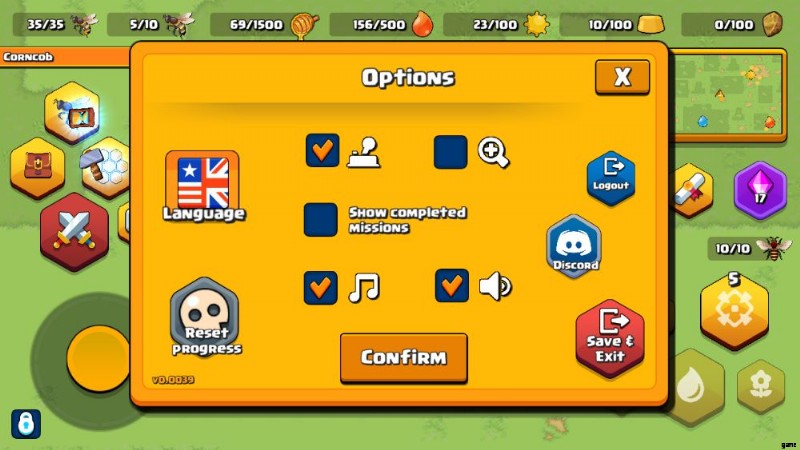
The default control scheme is pretty clunky, since you tap on a location on the screen to move. Thankfully you can set up the digital thumbstick found in most action mobile games in the Settings menu, which is the cog button next to your minimap.
This is good whether or not you’re on a tablet since it allows you to hold your device like a controller and aim spit shots more effectively, or on an emulator where you can put a digital D-pad on top of the joystick to move with the keyboard and keep you mouse hand free for other tasks like again, spitting at enemies.
Upgrade Priorities
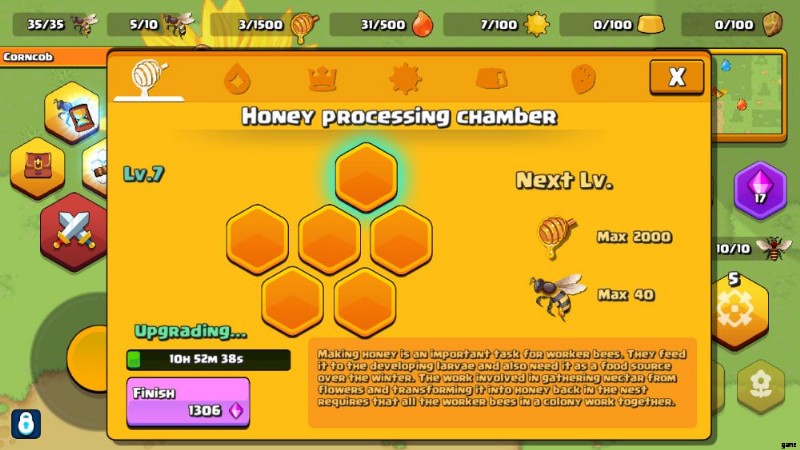
Your first priority for upgrades after the tutorial is the Honey Processing Chamber. Upgrading the Honey Chamber doesn’t just increase your Honey storage, it also increases the maximum amount of worker bees you can build. The earlier you can get a ton of them, the better, because like in any game, gathering resources is the most important thing. After all, you can’t maintain a hive without workers.
You can only upgrade the Honey Processing Chamber after you get a Nectar Storage, since it costs Nectar to upgrade. You also get loads of Nectar from the Story quest rewards, which makes that your second upgrade priority so you can readily accept them and use them for upgrades.
After that, Pollen Storage comes next as you need loads of Pollen and Honey to make Wax, the most important resource you have for upgrading your creatures.
Then you need at least a level 2 Propolis Storage so you can fit the 100 Propolis you need for your first Foraging upgrade, available from the blue fist icon on your screen. And once you want one of the later Propolis upgrades, get to work on the Propolis Storage again.
Last on the priority list is the Brood Chamber. While you need the lv1 Brood Chamber as fast as possible, further upgrades are mostly unimportant, though highly convenient. Upgrading the Brood Chamber makes your Guard Bees stronger but does not increase their maximum count, and allows you to breed more bees at a time.
You generally don’t need a high level Guard Bee squad if you know what you’re doing, as using your Guard Bees in PVP at all is normally a bad idea.
A Wax Storage at level 2 is also advised but not entirely necessary until you plan to upgrade the Propolis Storage, as you generally want to be able to make Wax with minimal material wastage. Having 100 Wax storage space rather than just 50 means you don’t need to completely empty your Wax supply before making two batches of 25 each.
All In Or Splits?

You have the option to divide your bees evenly between resources. The more bees on a single resource, the larger the haul but the longer it takes.
Say you have 15 bees; It takes a much shorter time to gather 5 Pollen, 5 Honey and 5 Nectar than it does to gather 15 Nectar and nothing else. Technically, per resource unit, splitting evenly is the most efficient option. That being said, once you get a few upgrades, you’ll mostly just spend your time gathering Honey and Pollen, and only taking Nectar if you want certain hive upgrades.
The game does reduce the time it takes per bee gathering a single resource though. The first bee takes one minute and after a ton of bees, each bee added to a single resource eventually adds only 20 seconds.
This means sending all your bees to gather a single resource during an emergency (You messed up and lost all your Guard Bees in a PVP match or a botched bumblebee fight, you’re close to a specific hive upgrade you want, you had the miserable luck of losing half your worker bees in a single foraging trip, etc.) is still a viable option.
All this is assuming you keep an eye on the timer of course. If you’re about to sleep or just want a chill time, just pick the one material you really want.
No Reward Must Go To Waste!

Before claiming really huge quest rewards, make absolutely sure they fit in your storage. Rewards that don’t fit in your storage are wasted if you try to claim them. Nothing is more irritating than losing 500 Nectar out of 1000 just because only 500 Nectar fits in your storage.
Before receiving any quest rewards, try and spend some of those materials you’re about to get to make space for them. Craft some Wax, see if anything can be upgraded, check if you have space for more Worker Bees, or make some extra Guard Bees.
Sniffing Pheromones:Bug Strengthening
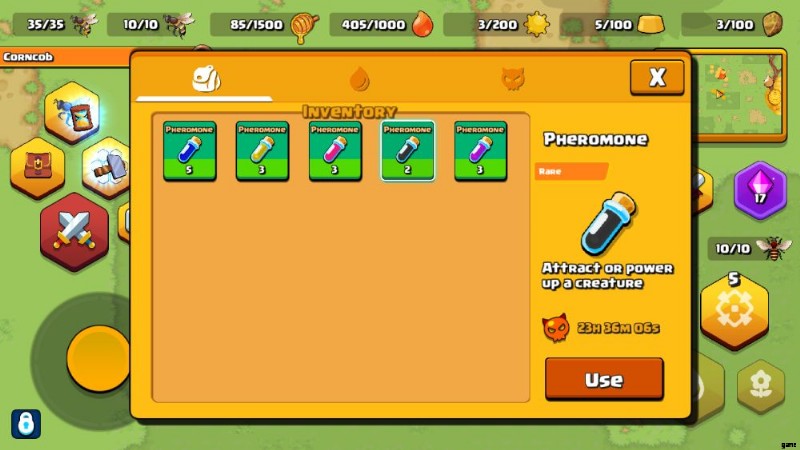
There is only one way to power up your PVP creatures:Gathering a ton of Pollen and Honey, turning it all into Wax, and using that Wax and Flower Sap to make their respective Pheromones to feed them with.
You can also use these Pheromones to summon them in the garden, so you can capture them, and they have relatively randomized (Beewolves are always tanky and Murder Hornets are always murderous, but some Beewolves and Murder Hornets are more tanky or murderous than others). Here are the facts in more detail.
Wax In, Wax Out
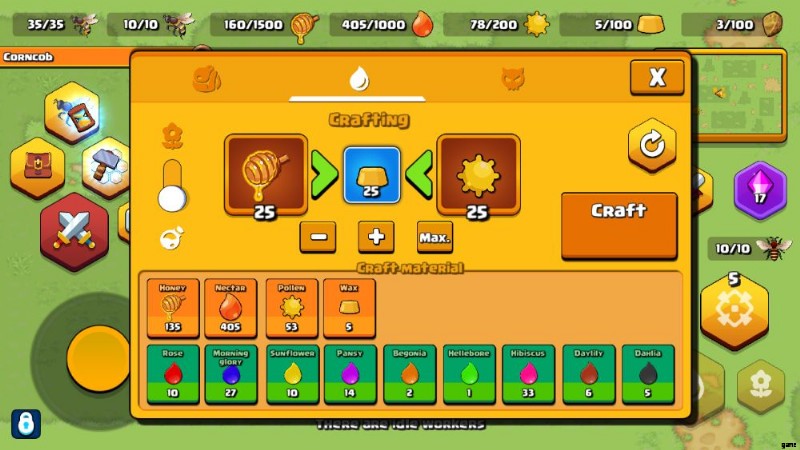
While you need lots of Nectar too, this is mostly just for hive upgrades, which are in service to the other two main resources in Pocket Bees:Honey and Pollen. Honey and Pollen make the most important resource in the game, Beeswax. Wax with Plant Sap is what you use to make Uncommon and Rare Pheromones, which you use to summon and upgrade Uncommon and Rare creatures, namely the Beewolf, Bee Eater, and Murder Hornet.
You will needs tons and tons of Wax, so you will usually put Pollen and Honey above Nectar in priority after you feel you’ve gotten enough Honey Chamber upgrades to get the worker bees you want, and after you grind your first 100 Propolis for the Foraging upgrade.
A Superior Specimen
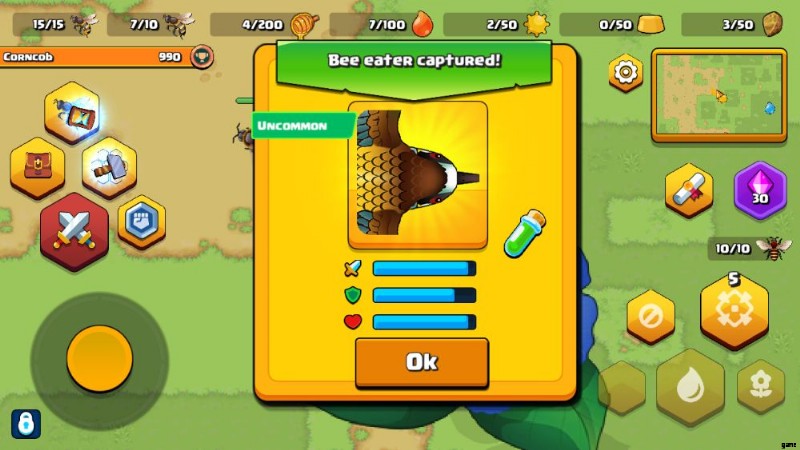
Bosses in your garden can be captured and sent to PVP battles. Don’t hesitate to beat as many of them as you can until you find one with really good randomized stats (though you don’t need triple full max stat bars, you just need all three bars to be near enough to max as by then the difference will be moot), then dump all the other weak ones of the same species to recoup the Sap costs.
Once you get a creature with the stats as high as they can go, start dumping Pheromone vials into them to level them up. And if you have two creatures of the same Rarity, try to get creatures with differing Pheromone colors so they don’t fight over Sap.
Get A Better Spider
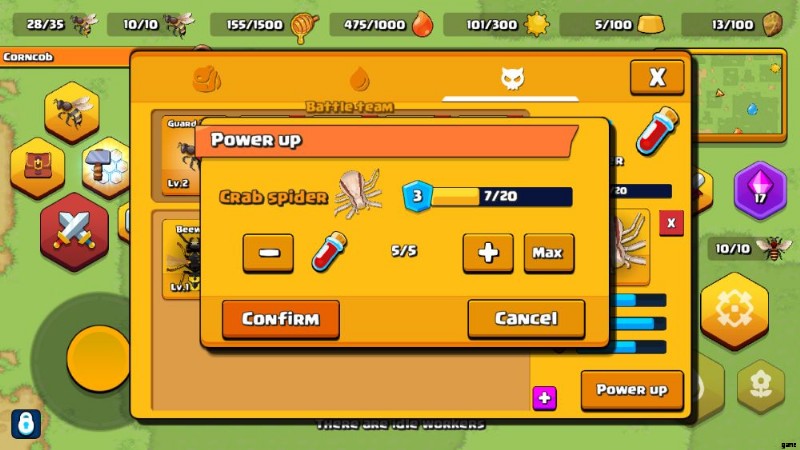
Of the two Common creatures, Crab Spiders and Humming Birds, the Crab Spider is generally considered the smarter choice thanks to its superior Defense, ability to mitigate its abysmal speed weakness with Constrict, and noticeably better Attack power.
The best advantage Common creatures have over other creatures, especially early on, is their cheap Pheromone cost:Common Pheromones do not require Wax to craft! Getting a high-stat Spider or any other critter that isn’t your Guard Bee squadron to level 5 will allow you to grind Noelle for a slow yet reliable trickle of Propolis if you aren’t sure about fighting other players.
2. GLADIATORIAL BUGFIGHT!
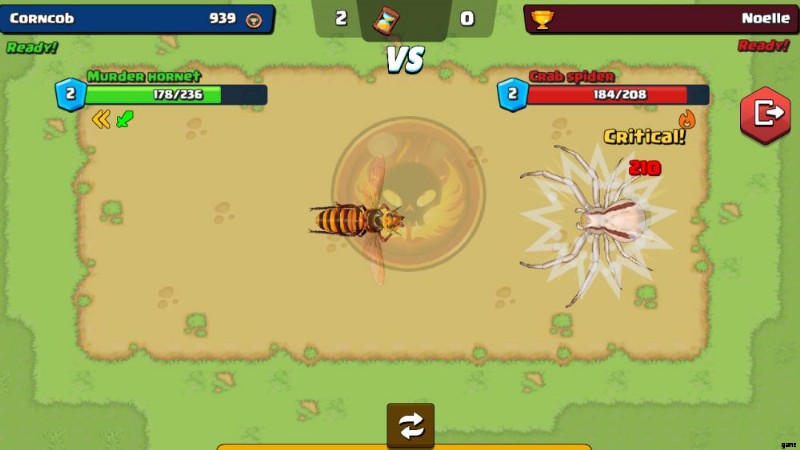
PVP in Pocket Bees consists of taking a squad of your Guard Bees and 4 creatures, and having them fight other people’s teams in turn-based combat. PVP is the only way to get Propolis, a resource that you can use for some of the most powerful upgrades in the game. Here are some notes about PVP to keep in mind.
Timed Retreat And Counter

All skill attacks have a cooldown of 3 turns after use, along with an initial delay of one turn the first time you pull the creature out for battle. This makes the early part of the fight the most important, since that’s when the heaviest damage will be done.
You should also keep a skill attack’s cooldown in mind, taking note if your opponent has used theirs recently. If you’re expecting your opponent to do a skill attack next and your current creature is injured, you can pull them away to let a tougher creature take the hit and punish the aggressor with your own initial 1 turn delay skill attack. Only kills count towards victory, with a total of three kills out of 5 winning a match, so you generally don’t want to sacrifice a creature unless you’re guaranteeing a kill on the next turn by doing so.
Also keep in mind your and your opponents’ buff and debuff skill cooldowns, as buffs and debuffs of the same kind completely demolish the other when used second (Evasion reduces enemy attack power “AND” nullifies Berserk when used second, not “OR”. Berserk increases your attack power “AND” nullifies the Evasion debuff when used second, not “OR”).
Last Resort
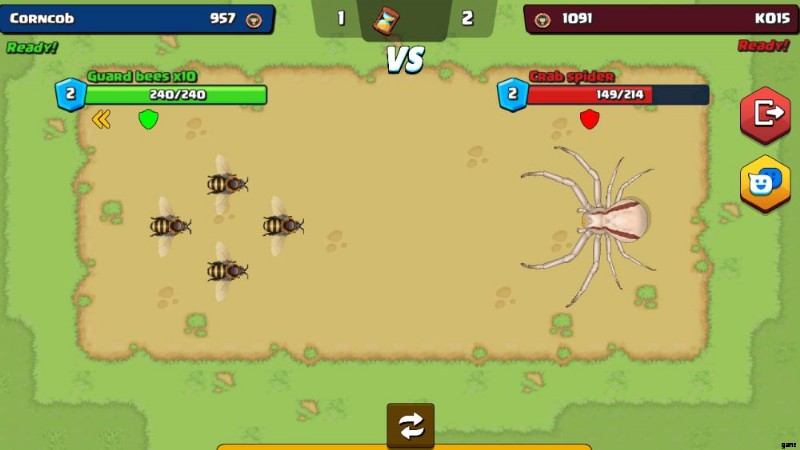
In PVP, the only losses you have to worry about are your Guard Bees. Boss creatures like Spiders and Humming Birds will be kept alive even after defeat. If you use the Guard Bees at all, you’re guaranteed to lose half of them if you win, and all of them if you lose even if you retreated them before death.
They are a bit harder to level up too; You need to upgrade the Brood Chamber by using loads of Pollen and waiting a long while, and you need to spend yet more time and Honey to replace them, and Propolis to increase their maximum count.
Knowing this, you generally won’t want to send your Guard Bees to battle unless you are absolutely sure that they will win the day. Sometimes though, that surprise Thermoball can win the match and the Propolis.
Know When To Fold ‘Em
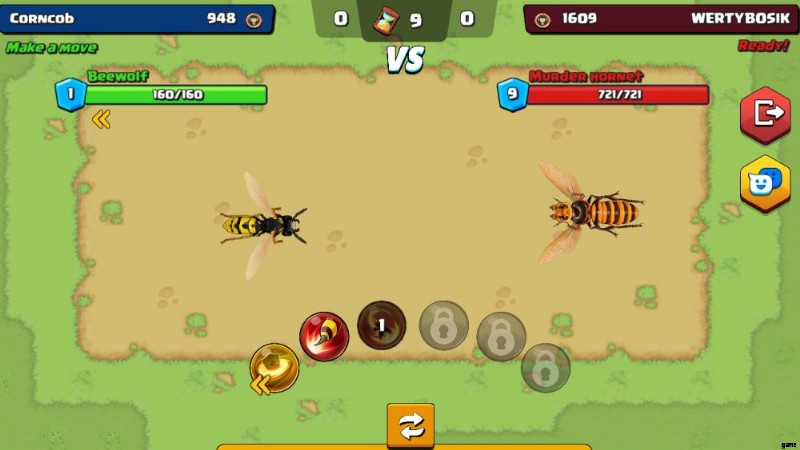
If it is glaringly clear that you will lose, like if you’re a newbie running a level 1 team and your opponent pulls an overleveled Murder Hornet out of nowhere, tuck tail and run! It isn’t worth fighting to the bitter end since losing trophies isn’t nearly as bad as losing trophies and your Guard Bees.
It’s time better spent looking for an opponent you can actually fight. You shouldn’t worry about wasting your battle tokens either, as you can easily get them by watching ads, which is discussed in the next tip.
Keep Spending Those Battle Tokens
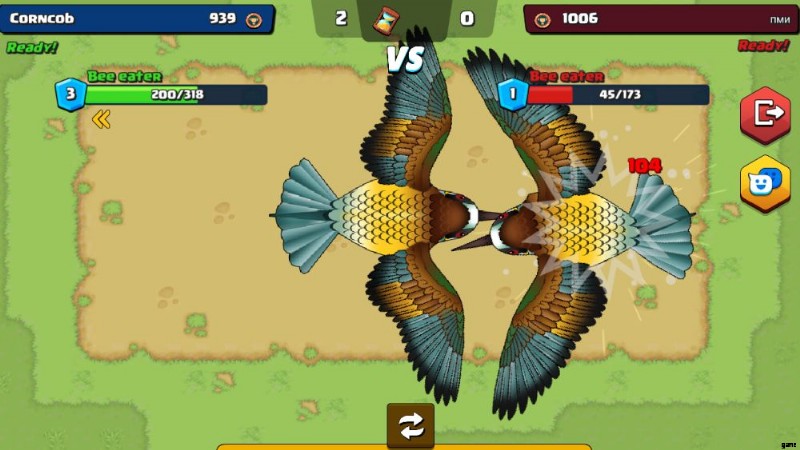
Most earlygame PVP fights in Pocket Bees will be hell to get through. Matchmaking only cares about how many trophies you’ve got and doesn’t give a hoot if your enemy is overleveled enough to kill your birds and bees in one shot, or if your own team is powerful enough to do the same. That being said, battle tokens are extremely easy to come by:You get one by watching an ad in the purple crystal menu, and unlike in most other games with ad rewards, there is absolutely no limit to how many times you can do this.
As soon as you get a full sized team with a Murder Hornet in it and get a level 2 Propolis storage, just keep at it until you find an opponent with creatures equal to your level. Some of the upgrades you can get by spending Propolis are extremely powerful.
In particular the first level of Foraging which makes each of your Worker Bees carry one extra resource without taking extra from whatever flowers they’re gathering from. You’ll need that to start leveling your creatures properly, as you’ll require a lot of Pollen and Honey to mass-produce Wax to make all those Pheromone vials your creatures want so badly.
And oddly enough, once you’ve got a leveled team with either a single lv5 creature or a whole team at around lv3 and lv2, fighting Noelle becomes a very reliable source of Propolis compared to fighting real people, even though she only gives 3 and not 10 from a win.
This is because Noelle’s strength only goes up to level 3, so eventually you can guarantee wins against her as opposed to fighting real people, where you are at the mercy of the matchmaker’s randomness. In the end, grinding is a bee’s life, whether it be in the garden or in PVP.
3. ANGRY LITTLE BUGS AND BIRDS:THE CREATURE LIST
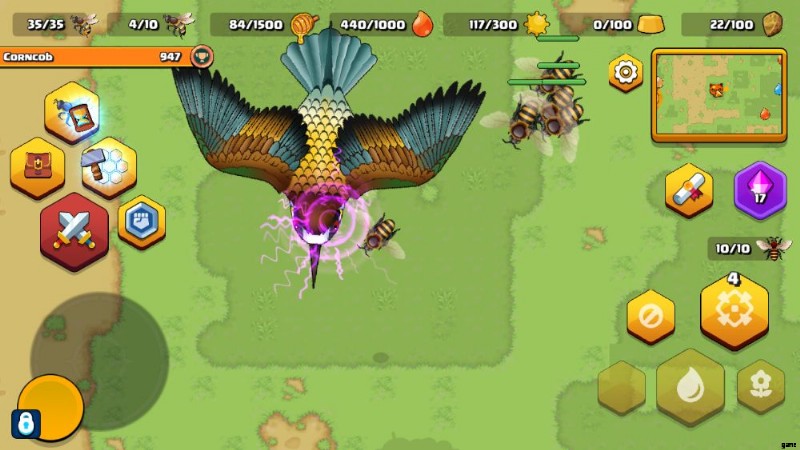
At the moment, there are five creatures in Pocket Bees. In spite of having rarities like Common, Uncommon and Rare, those don’t matter much other than for how hard it is to level them up, and even then not by much once you have Wax production running smoothly.
All of them have some tactical use, and their level and randomized stat quality matters much more than their rarity. You can only bring 4 creatures plus all your Guard Bees to a battle. As a side note, the Health stat does not accurately represent a creature’s current max HP, as that depends on their level and stat bar quality.
Here they are!
Crab Spider
COMMON, Tank, Debuffer, Dancing Beauty

Named for the way they hold their front legs up and their tendency to walk sideways, the Crab Spider is the first creature all players capture.
Crab Spiders have the second highest defense in the entire game at 320, but are also the slowest with the utterly miserable speed of 100, meaning they tend to hit second during a fight.
It has a skill to mitigate this, called Constrict, which reduces an enemy’s speed and can force them to attack last instead. Its skill attack is particularly dangerous, the Spider Web. It can paralyze its target and skip their turn, more than making up for its fairly lackluster damage no thanks to the Spider’s attack stat of 220.
While their health is the lowest at 220, their armor more than makes up for that. Crab Spiders are a pretty solid pick that can take on most opponents even as a starter creature.
Murder Hornet
RARE, Damage Dealer, A Sting Like Burning Nails
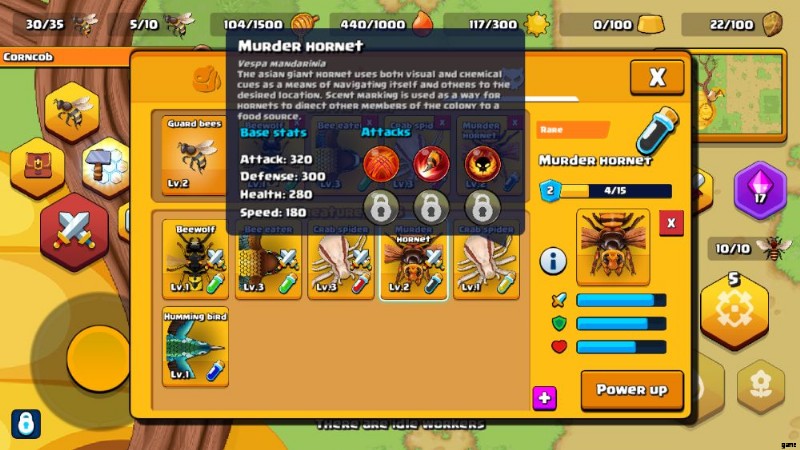
A real-life insectoid horror with a sting so painful and deadly that Chinese military engineers, various people on Youtube, and the writer of this article, all agree that using flamethrowers on their nests is a perfectly rational decision.
The aptly-named Murder Hornet is not to be trifled with. These guys are just as dangerous in the game, technically having only the second highest attack power at 320 just behind the dreaded Bee Eater and yet being capable of hitting much harder thanks to their highly aggressive skillset. Apart from their basic attack, they have the Berserk skill which increases their already good attack stat to ludicrous levels, and a special attack just straight up called Murder.
Using Berserk before Murder often causes a one hit kill against anything of equal level, unless it’s a Beewolf with Armor active. If it somehow doesn’t kill the victim, it has a chance to set that poor sucker on fire for three turns, which isn’t much worse compared to what a swarm of them can do to you in real life.
They are also decently bulky at 300 defense and 280 health. Too bad the only thing slower than they are is the Crab Spider, and they don’t have Constrict to make up for it. They will often hit second, but will also wreck the enemy’s face in the process while still taking the hit relatively decently.
Bee Eater
UNCOMMON, Damage Dealer, Debuffer, Angry Bird
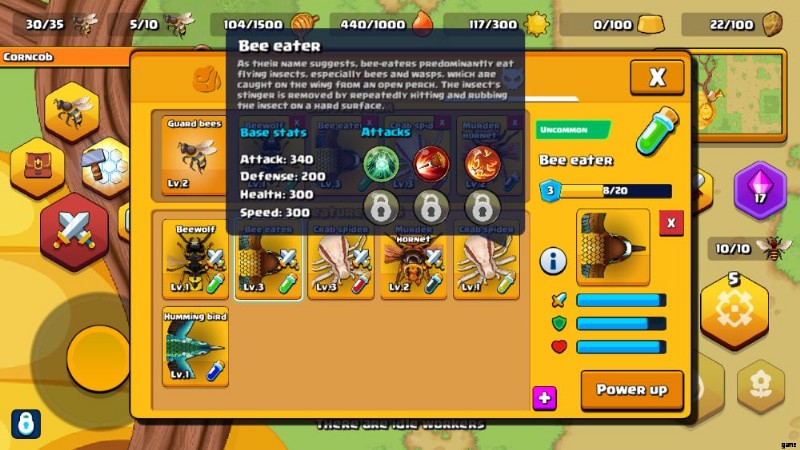
A bird that, as its name implies, eats bees and wasps. In real life they do so by violently smashing their victims onto hard objects to rip their stingers off.
Statwise, Bee Eaters are glass cannons, with a pitiful defense of 200 but an alarming speed of 300 and an attack stat of 340, the fattest in the game outside of a Murder Hornet going Berserk. While they generally have good stats, their skill attack, Wing Attack, simply hits hard but doesn’t do much else.
Its Wingbeat skill can lower the enemy’s defense though, so it’s best used against Beewolves (You can use Wingbeat to negate the effects of the Armor skill completely) and Crab Spiders, which have the strongest defenses in Pocket Bees. Think of them as squishier Murder Hornets that often shoot first.
Beewolf
UNCOMMON, Tank, Armored Sting-Bouncer
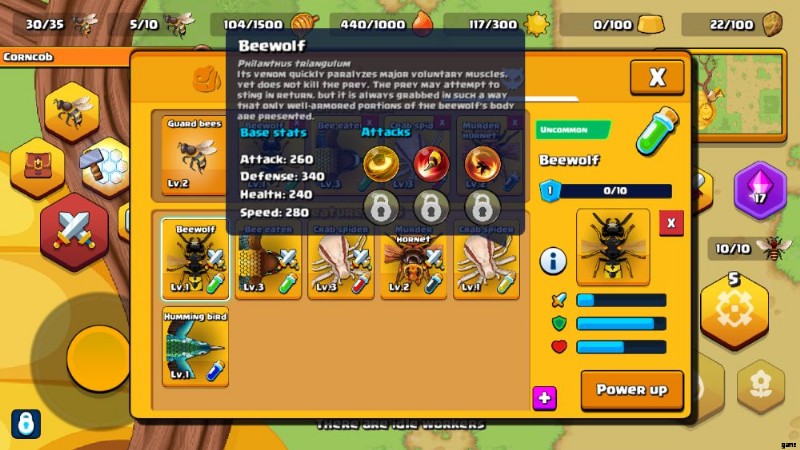
Heavily armored predatory wasps who paralyze bees while angling their thick exoskeletal plating towards their desperate stings, Beewolves have the strongest defense in the game at 340. They also have a base health of 240, and a decent speed of 280, right in the middle, with an okay but not amazing attack stat of 260.
They’re a beating stick much like Bee Eaters, as their high stats are a little bit let down by their fairly ordinary skill attacks. Hunt is definitely worse than Wing Attack, as they are exactly the same except Wing Attack is backed up by the Bee Eater’s incredible attack stat.
On the other hand, Beewolves have the Armor skill, increasing their already impressive defense even further, allowing them to fritter away their opponent and survive attacks even from certain foes a higher level than them. If there’s anything that can survive a Murder Hornet’s killing blow then punish it, it’s the Beewolf.
Humming Bird
COMMON, Fast Attack, Little Feathery Butterflies
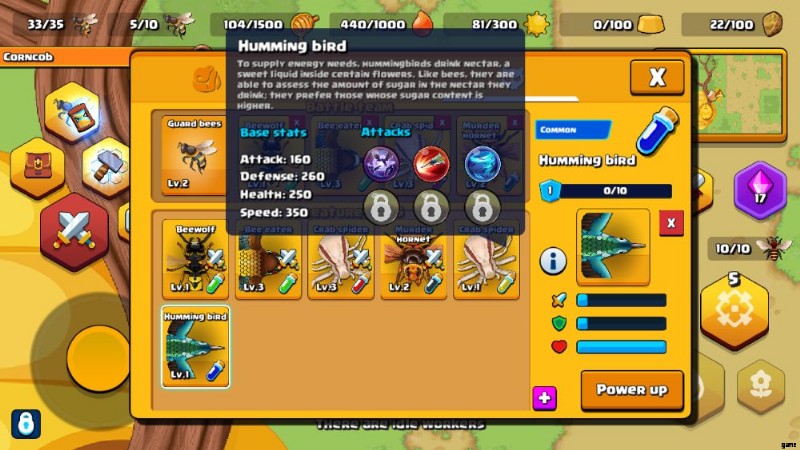
Strange, tiny birds that drink nectar much like a butterfly and are known for their fantastic flight agility, ability to hover, and poor energy efficiency.
Humming Birds are the fastest creatures in Pocket Bees with a base speed of 350 , and will always hit first barring a Constrict attack from a Crab Spider. Their bulk is neither bad nor good, at 260 base defense and 250 base Health.
They can decrease an enemy’s damage with their Evasion skill (Useful to nullify a Murder Hornet’s Berserk buff, though matching a Humming Bird against an equal level Murder Hornet is generally a bad idea), and their Humming Wind attack has a chance to paralyze its target much like Spider Web.
Unfortunately they have bottom-of-the-barrel attack power at 160, and their speed isn’t much use when every other creature overpowers them so badly. Their speed can be used to finish enemies off before they can do desperation skill attacks though.
Guard Bees
NO RARITY, General Purpose, Jealously Guarded Swarm
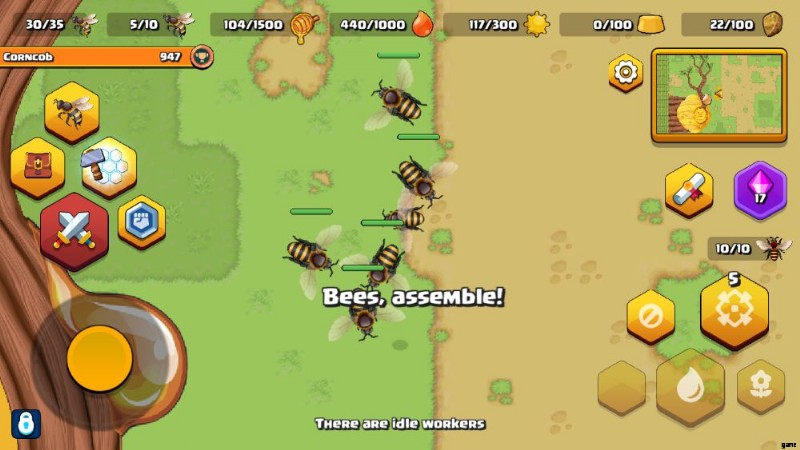
Last of all, you have your ever loyal Guard Bees, possibly based on Japanese honeybees judging by their Thermoball attack and good looks. They work differently compared to other creatures in that their power isn’t only from their level, but also from their numbers.
If you plan to use them in PVP (generally a terrible idea unless it’s as a last ditch attack with a high level squadron, the garden squad size limit and the fact you need Honey to make Wax is why we suggest only having 5 of them at any given time for garden work), make sure you’ve got as many of them as possible to boost their stats.
They work like a hybrid of Beewolves and Murder Hornets, as they have similar abilities. Teamwork buffs the bee squadron’s defense ala Armor, and Thermoball acts a lot like Murder, being a highly damaging attack with a chance to set the victim on fire.
That being said, replacing them takes one minute and 15 Honey each, so getting them shot down is utterly painful. Not to mention if they’re all dead, you aren’t allowed to enter PVP until you replace them and have at least one Guard Bee. Only use them if you’re absolutely sure that you’ll win by sending them in.
And this is the end of our Pocket Bees:Colony Simulator beginner’s guide. While the early game is rough, things tend to go more smoothly after your first Foraging upgrade and a few hive upgrades, as now you can efficiently power up your creatures. Hopefully this guide helps with getting past that initial hurdle. If you have any tips of your own or just want to talk with your fellow players, leave a comment below!
